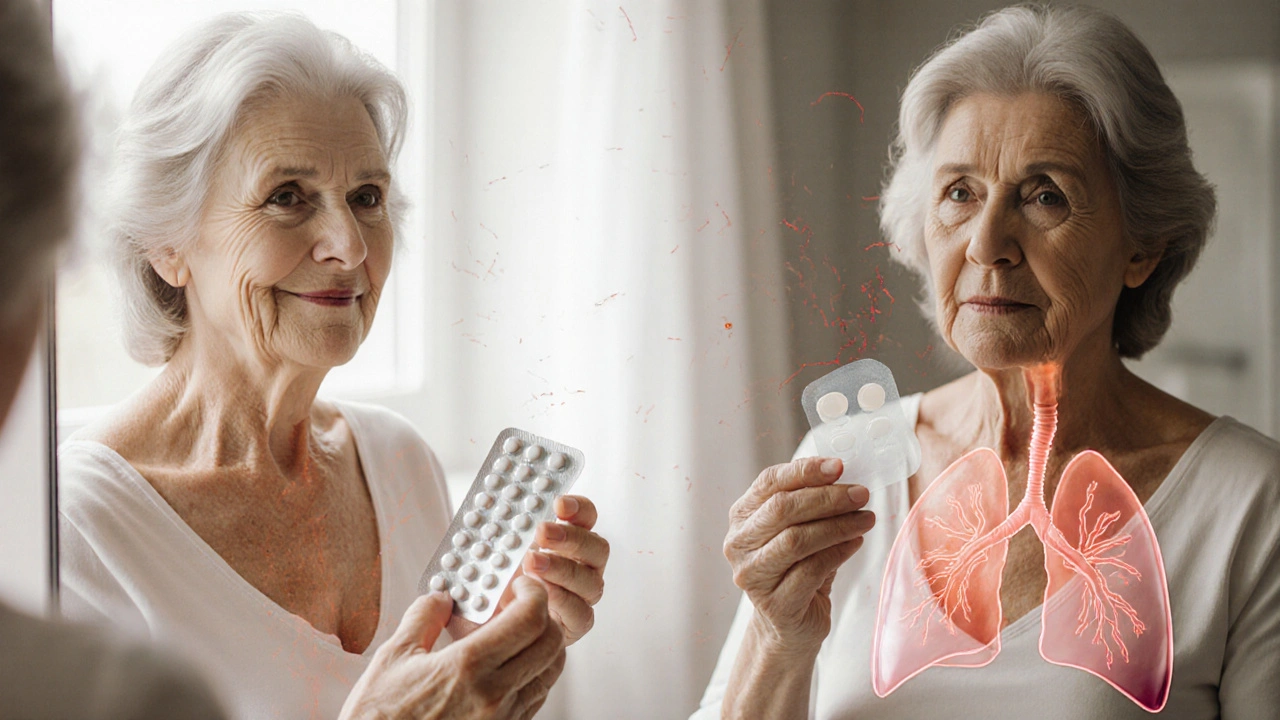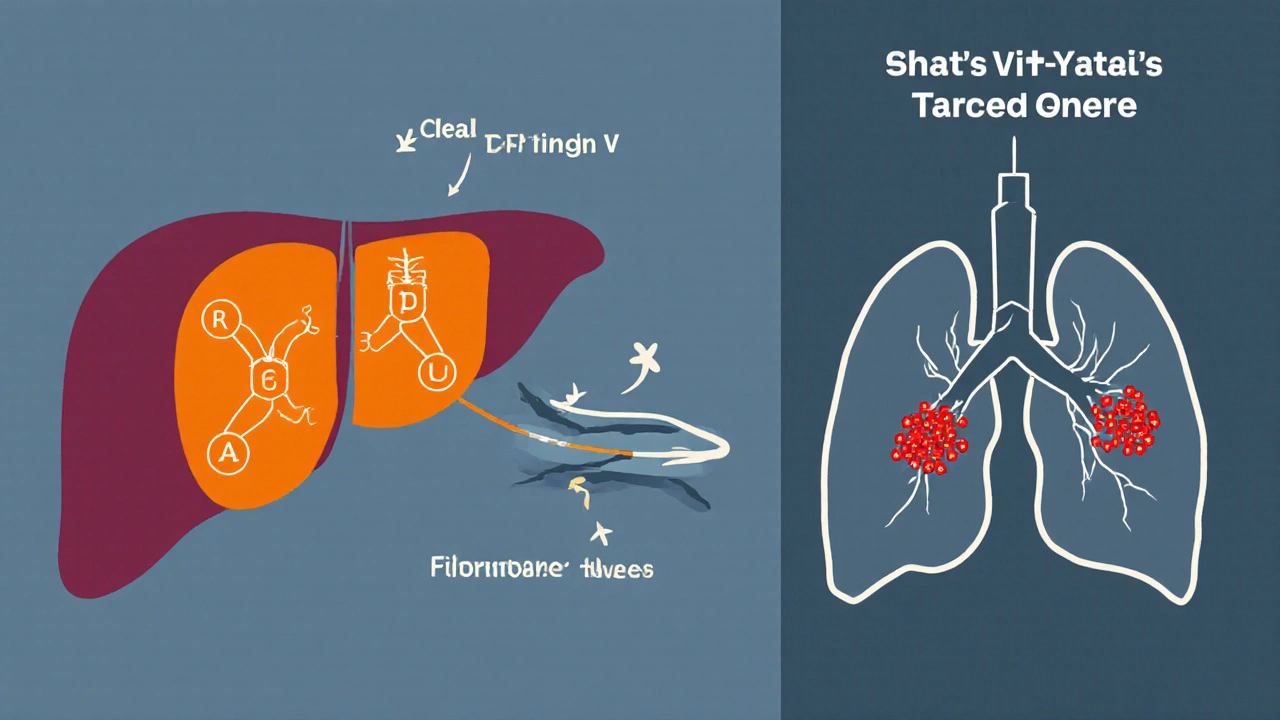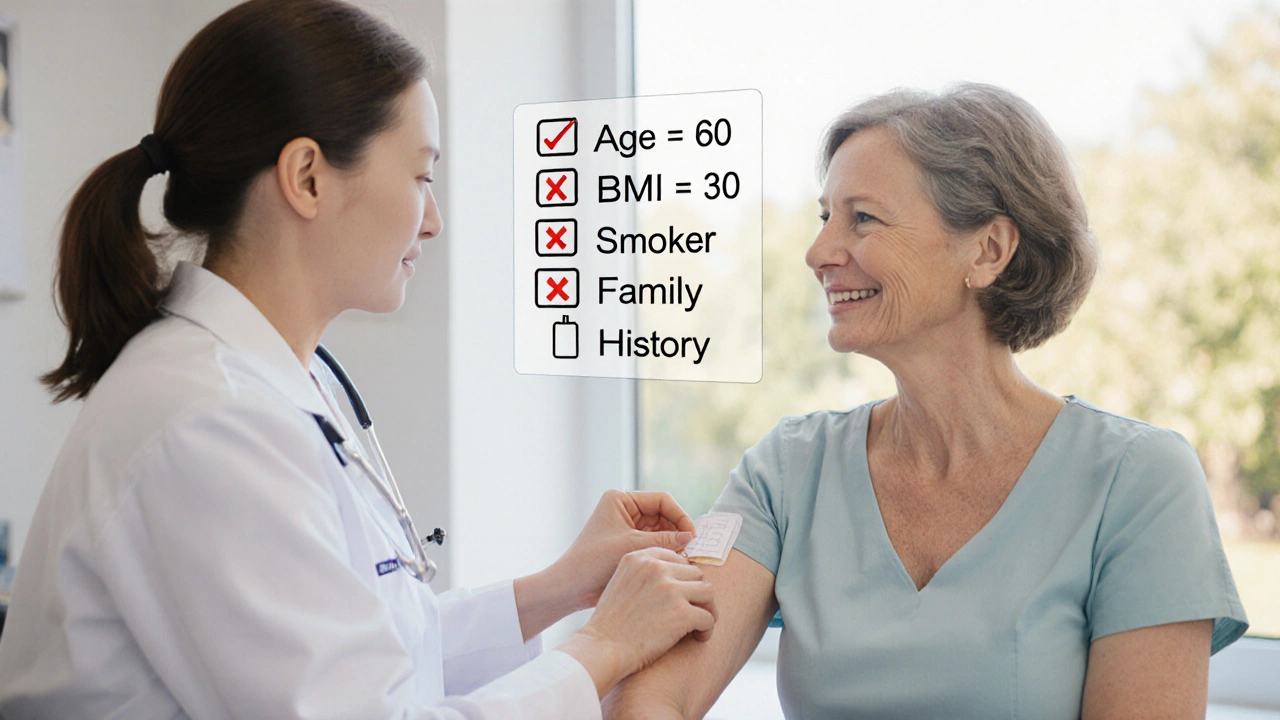Hormone Replacement Therapy and Pulmonary Embolism: What You Need to Know
 Oct, 12 2025
Oct, 12 2025
HRT Pulmonary Embolism Risk Calculator
This calculator estimates your relative risk of pulmonary embolism (PE) when taking hormone replacement therapy (HRT) based on your specific factors. Risk is compared to the baseline risk for someone not taking HRT.
How to interpret your result: This is the relative increase in risk compared to someone not taking HRT. For example, a 30% risk means you have a 30% higher chance of developing a pulmonary embolism than someone without HRT.
Ever wondered whether the pills or patches you take to balance hormones could set off a dangerous clot in your lungs? The short answer is that certain forms of hormone replacement therapy do tip the scales toward blood clots, but the risk isn’t the same for every woman or every product. This article walks you through what HRT is, how it can spark a pulmonary embolism, who should be extra cautious, and what steps you can take to stay safe.
Key Takeaways
- Estrogen‑based HRT raises the chance of blood clots, especially when taken orally.
- Transdermal (patch or gel) delivery carries a markedly lower clot risk.
- Age over 60, obesity, smoking, and a history of Venous Thromboembolism a condition that includes deep‑vein thrombosis and pulmonary embolism are the biggest red flags.
- Typical symptoms of a pulmonary embolism include sudden shortness of breath, chest pain that worsens on inhaling, and rapid heartbeat.
- If you suspect a clot, seek emergency care immediately - early diagnosis saves lives.
Let’s break down the science, the numbers, and the practical steps you can take.
What Is Hormone Replacement Therapy?
Hormone Replacement Therapy (HRT) is a medical treatment that supplies estrogen, progesterone, or a combination of both to women whose natural hormone levels have dropped, usually after menopause. The goal is to relieve hot flashes, prevent bone loss, and improve quality of life. HRT comes in several formats: oral tablets, skin patches, gels, creams, and even vaginal rings.
Estrogen a primary female sex hormone that regulates menstrual cycles and influences bone density is the component most often linked to clotting changes. Progesterone, when added to balance estrogen’s effects on the uterus, appears to have a neutral or slightly protective impact on clot risk.
What Is a Pulmonary Embolism?
A pulmonary embolism (PE) is a blockage in one of the pulmonary arteries, usually caused by a blood clot that traveled from the deep veins of the legs (deep‑vein thrombosis, or DVT). When that clot lodges in the lungs, it can reduce oxygen flow and strain the heart.
Pulmonary Embolism a potentially life‑threatening condition where a clot blocks blood flow to the lungs can cause sudden shortness of breath, chest pain, rapid pulse, and in severe cases, loss of consciousness.

How HRT May Increase Pulmonary Embolism Risk
The link between HRT and clotting is rooted in estrogen’s influence on the blood‑coagulation system. Estrogen raises levels of clot‑promoting proteins like fibrinogen and factor VII, while lowering natural anticoagulants such as protein S. This shift makes the blood more “sticky,” especially in veins where blood moves slowly.
Route matters a lot. Oral estrogen travels through the liver first (the “first‑pass” effect), which amplifies clot‑factor production. Transdermal delivery bypasses the liver, resulting in a far smaller impact on coagulation.
Progesterone a hormone often combined with estrogen in HRT to protect the uterine lining on its own does not appear to increase clot risk, but when combined with high‑dose oral estrogen the overall clot potential rises.
What the Research Says
Large studies provide a clear picture:
- Women’s Health Initiative (WHI) trial (2002): Women taking oral conjugated equine estrogen plus medroxyprogesterone saw a 1.5‑fold increase in venous thromboembolism (VTE) compared with placebo.
- Observational studies (2015‑2023): Meta‑analyses of more than 1.2million women show that oral HRT raises PE risk by roughly 30‑40%, while transdermal patches raise it by about 10% or less.
- Recent UK‑based cohort (2024): Women over 60 using oral estrogen had an absolute PE incidence of 7 per 10,000 person‑years versus 3 per 10,000 for patch users.
These numbers mean that for most younger, healthy women, the absolute increase in risk remains low. However, the relative increase becomes clinically important when other risk factors are present.
Who Is Most at Risk?
Not every woman on HRT faces the same danger. The biggest predictors of a clot while on therapy are:
- Age≥60years
- Body mass index (BMI)≥30kg/m² (obesity)
- Current smoking
- Personal or family history of Deep Vein Thrombosis a clot that forms in the deep veins, usually of the legs or previous PE
- Genetic clotting disorders (e.g., Factor V Leiden, prothrombin G20210A mutation)
- Immobilization for long periods (post‑surgery, long flights)
If you tick any of these boxes, a clinician will likely recommend a lower‑dose or transdermal regimen, and may suggest baseline blood tests to assess clotting tendency.
Spotting the Warning Signs
PE can masquerade as a mild flu, but there are tell‑tale clues:
- Sudden, unexplained shortness of breath that worsens with activity
- Sharp chest pain that’s worse when you take a deep breath (pleuritic pain)
- Rapid heartbeat (tachycardia) or irregular pulse
- Light‑headedness, fainting, or a feeling of impending doom
- Swelling or pain in one leg, sometimes accompanied by a red or discolored appearance
Because a PE can be fatal within minutes, any combination of these symptoms warrants urgent medical evaluation.

How to Reduce the Risk
Here’s a practical checklist you can discuss with your doctor:
- Choose the right route: Opt for transdermal patches or gels whenever possible. They keep clot risk close to baseline.
- Use the lowest effective dose: “Micro‑dose” formulations (e.g., 0.5mg estradiol) achieve symptom control with far less impact on clotting factors.
- Screen for clotting disorders: If you have a family history of VTE, ask for a thrombophilia panel before starting HRT.
- Control other risk factors: Quit smoking, maintain a healthy weight, stay active, and keep blood pressure and cholesterol in check.
- Re‑evaluate regularly: Review the need for continued HRT every 6‑12months. Discontinue if side effects outweigh benefits.
Guidelines from the American College of Obstetricians and Gynecologists (ACOG) and the UK’s NICE advise that clinicians weigh the clot risk against bone‑health and quality‑of‑life benefits, especially for women under 60 with no additional risk factors.
What to Do If You Suspect a Pulmonary Embolism
If you’re experiencing the symptoms listed above, act fast:
- Call emergency services (dial 111 in NewZealand). Do not wait for a doctor’s appointment.
- Tell the responders you are on HRT. This information helps them prioritize imaging and anticoagulation.
- Diagnostic work‑up: Most hospitals will order a CT pulmonary angiogram or a ventilation‑perfusion (V/Q) scan, plus D‑dimer blood testing.
- Treatment: Immediate anticoagulation (e.g., low‑molecular‑weight heparin) followed by oral anticoagulants for 3‑6months, depending on whether the clot was provoked (by HRT) or unprovoked.
- Follow‑up: After the acute phase, discuss with your doctor whether to stop HRT permanently or switch to a safer route.
Prompt treatment reduces the 30‑day mortality rate from about 15% down to under 5%.
Oral vs. Transdermal HRT: A Quick Comparison
| Aspect | Oral HRT | Transdermal HRT |
|---|---|---|
| Clot risk (VTE/PE) | 30‑40% increase vs. baseline | ≈10% increase or none in many studies |
| First‑pass liver effect | Yes - amplifies clot‑factor production | No - bypasses liver |
| Typical dosing frequency | Daily pill | Twice‑weekly patch or daily gel |
| Side‑effects (besides clot risk) | Nausea, bloating, breast tenderness | Skin irritation (patch), rare |
| Convenience for travel | Easy to pack | Patch adhesive may be problematic in hot climates |
When clot risk is the primary concern, most clinicians steer patients toward the transdermal option.
Frequently Asked Questions
Does HRT cause blood clots in everyone?
No. Only certain formulations, especially oral estrogen, modestly raise clot risk. Younger, healthy women without additional risk factors often experience a very small absolute increase.
Can I switch from pills to a patch if I’m worried about clots?
Yes. Most doctors consider a patch or gel a safer alternative for women with any clot‑risk factors. Discuss dosage and monitoring with your provider.
How long does it take for the clot risk to drop after stopping HRT?
Risk falls back to baseline within about 4‑6weeks after discontinuation of oral estrogen. Transdermal users see an even quicker reduction.
Should I get blood tests before starting HRT?
Baseline labs are a good idea, especially if you have a family history of clotting. Tests may include a complete blood count, lipid panel, and, if indicated, a thrombophilia screen.
Is there a safe “no‑risk” HRT option?
No therapy is completely risk‑free, but low‑dose transdermal estrogen is the closest to a no‑risk option for most women without pre‑existing clotting disorders.
Bottom line: Hormone replacement therapy can increase the odds of a pulmonary embolism, but the magnitude depends heavily on the hormone type, dose, and delivery method. By choosing a transdermal route, staying within the lowest effective dose, and keeping an eye on personal risk factors, you can enjoy the benefits of HRT while keeping clot risk to a minimum. Always have an open conversation with your healthcare provider-you know your body best, and they have the data to guide a safe plan.
ahmad matt
October 12, 2025 AT 19:40Look the whole hype around HRT is a circus the risk numbers you tossed in are just a smokescreen they sound scientific but they hide the ugly truth that oral estrogen is a clot factory the liver gets flooded and churns out clotting proteins like crazy the transdermal patch is a lazy compromise that still puts you on a hormone train the “low risk” label is a marketing trick that lulls people into a false sense of safety you think a 30 percent bump is tiny but in a population of millions that translates to thousands of lives on the line the age factor isn’t a suggestion it’s a red flag screaming stop you over 60 and you’re basically waving a neon sign for doctors to watch you closely the BMI column reads like a guilt trip you’re either normal or you’re overweight or you’re obese there is no middle ground the smoking data is blunt it adds an extra punch to an already ticking time bomb the VTE history line is a warning siren that should shut the whole HRT conversation down the guidelines you quote are a sugar coat for pharma profits the “choose the lowest dose” advice feels like a patronizing pat on the head you deserve better than vague recommendations the reality is that any estrogen that travels through the gut ramps up clot potential the patch bypasses the liver but it’s not a free pass it still carries some risk the bottom line is that HRT is a gamble you either play it safe with the patch or you roll the dice with pills the medical community should stop sugar coating and start being brutally honest about the numbers the patients deserve that raw truth not a glossy calculator
kristine ayroso
October 16, 2025 AT 07:00Hey there I totally get the concerns you raised and I think it’s important to remember that every woman’s situation is unique I’ve seen folks switch from pills to patches and feel a lot more at ease the key is to have an open chat with your doc and maybe ask for a clotting panel if you have any family history it’s not about sugar coating it’s about giving options and support you’re not alone in this
Ben Small
October 19, 2025 AT 18:20Patch over pill any day.
Dylan Hilton
October 23, 2025 AT 05:40The calculator is handy but don’t let it replace a real conversation with a healthcare professional it’s a nice visual aid but the nuances of personal health history, genetics, and lifestyle choices can shift the risk dramatically. Think of it as a starting point, not the final verdict.
Christian Andrabado
October 26, 2025 AT 16:00While the tool is useful it can’t capture the emotional toll of living with that lingering fear of a clot. The anxiety itself can impact overall wellbeing and should be part of the decision‑making process.
Chidi Anslem
October 30, 2025 AT 03:20From a broader perspective, hormone therapy is more than a medical choice; it intertwines with cultural narratives about aging and femininity. In many societies, denying symptoms like hot flashes feels like surrendering to age, which influences how women perceive the trade‑off between quality of life and clot risk.
Holly Hayes
November 2, 2025 AT 14:40i get the point but honestly some ppl just want to look young and dont care abt a tiny risk
Penn Shade
November 6, 2025 AT 02:00Let’s be clear: the data consistently shows oral estrogen carries a higher VTE risk than transdermal. The WHI trial and subsequent meta‑analyses are not anecdotal; they provide robust evidence that should steer prescribing practices toward skin‑based delivery whenever possible.
Jennifer Banash
November 9, 2025 AT 13:20While the statistical evidence is compelling, it is crucial to present it with both compassion and precision. A balanced discourse acknowledges the undeniable benefits of symptom relief while unequivocally highlighting the quantifiable increase in thrombotic events associated with oral formulations.
Stephen Gachie
November 13, 2025 AT 00:40Philosophically speaking, the decision to initiate HRT is an exercise in personal autonomy weighed against collective medical wisdom. One must reconcile the desire for immediate quality‑of‑life improvements with the probabilistic nature of future health risks, a classic case of present bias versus long‑term rationality.
Sara Spitzer
November 16, 2025 AT 12:00The philosophical framing is interesting but at the end of the day a woman needs clear, actionable guidance-not abstract musings. Doctors should translate those probabilities into concrete recommendations: patch first, low dose, monitor labs.
Jennifer Pavlik
November 19, 2025 AT 23:20Bottom line: talk to your doctor, consider a patch, and keep an eye on any other risk factors you have.
Jacob Miller
November 23, 2025 AT 10:40That’s solid advice but don’t forget to ask about baseline clotting tests, especially if you have any family history. It’s better to be proactive than reactive.
Anshul Gandhi
November 26, 2025 AT 22:00There’s a darker side to this whole HRT conversation that rarely gets aired - the pharmaceutical industry’s influence on guidelines is massive. Look at the way the WHI data was interpreted; funding sources subtly shape the narrative that oral estrogen is “acceptable” for many. The patch is marketed as a premium product, priced higher, yet the clinical advantage is modest. Some clinicians, perhaps unintentionally, become conduits for profit rather than patient‑centered care. It’s not a conspiracy in the classic sense, but a systemic bias that steers prescribing habits toward the more lucrative formulation. When you slice through the marketing fluff, you see a pattern: drugs that generate recurring revenue get more favorable positioning in guidelines. Patients deserve transparency about these hidden incentives. Informed consent should include a discussion about how drug pricing and industry ties could affect the recommendation you receive. Stay skeptical, ask about alternatives, and consider the cost‑benefit beyond just the clot risk numbers.
Emily Wang
November 30, 2025 AT 09:20All that sounds serious and it’s worth digging into, but at the end of the day the most immediate step is to evaluate your personal health profile. If you have the risk factors listed, a patch and low dose is the pragmatic move while you keep an eye on any new research.